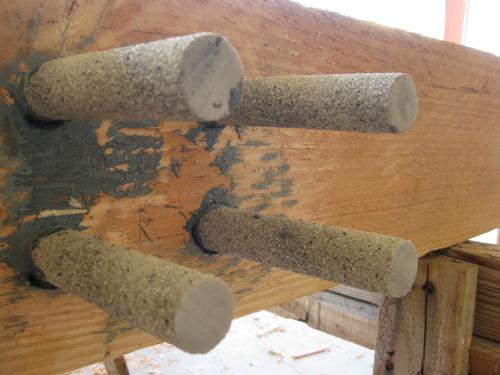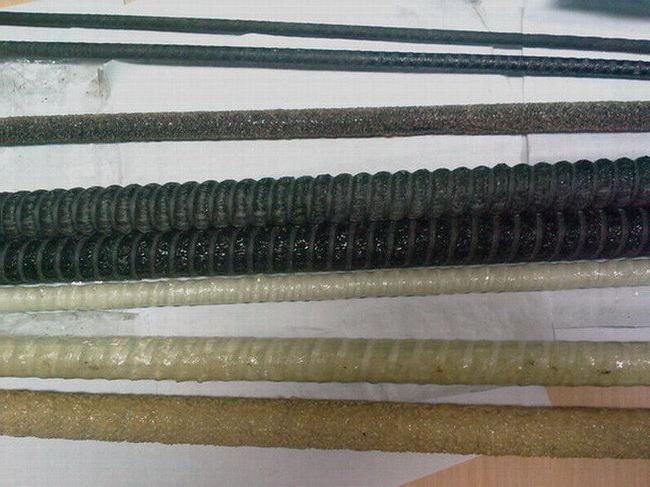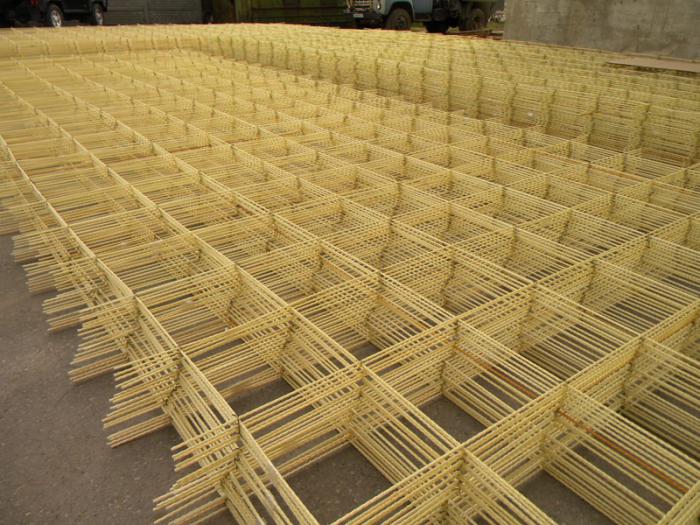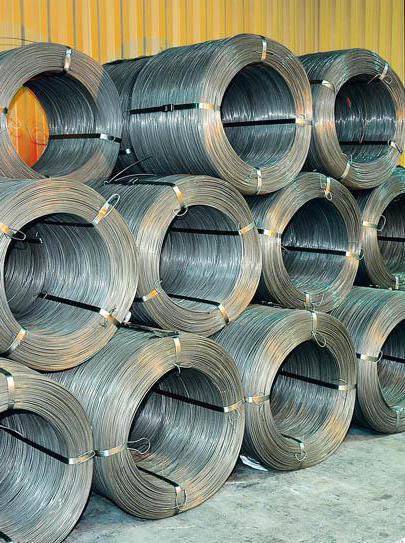Fiberglass reinforcement: disadvantages, characteristics, application
In construction, as in other industries, allmore often resort to the use in the production of goods and services of the latest technology and innovative approaches. Fiberglass reinforcement is an example of such an alternative solution. It quickly replaced the traditional metal parts, overtaking them by economic and technical parameters. From this article you will learn what a fiberglass reinforcement is. The characteristics of this material will be presented in comparison with others.

Fiberglass reinforcement - what is it?
Reinforcing agent, or non-metallicfiberglass reinforcement, is a kind of rod with a ribbed surface of glass fibers. Its profile is spiral-shaped, and the diameter varies from 4 to 18 mm. The length of the reinforcement can reach up to 12 meters. Sometimes it occurs in the form of twisted bays, the diameter of such a building material is 10 mm.
Abroad, fiberglass reinforcement, applicationwhich is as widely used as in our country, is called polymer equipment. It is strengthened by a continuous fiber. In Russia, you can often find the abbreviation AKC.

What does the fiberglass reinforcement consist of?
The physical body of the AKC consists of several parts:
1. The main trunk. It is made of parallel fibers, which are connected by a polymer resin. The main barrel ensures the strength of the reinforcement.
2. The outer layer is a fibrous body. It winds in a spiral around the trunk of the AKS. Occurs in the form of sand spray or bi-directional winding.
There are various variations of fiberglass, alldepends on the manufacturer's imagination and the appropriateness of know-how. On sale you can find reinforcement, the main trunk of which is made in the form of braids from carbon fiber.
Basic properties
To determine the properties of fiberglass, it wasa lot of research and tests have been carried out. The obtained results characterized AKS as high-strength and durable equipment for construction, which has a number of advantages over other materials:
- light weight (fiberglass lighter than metal reinforcement 9 times);
- resistance to corrosion in acidic and aggressive chloride environments (10 times higher than that of steel reinforcement);
- low thermal conductivity;
- economy (it is more profitable to transport, and replacement is less frequent);
- magnetoinertivity;
- radio transparency;
- the armature is a dielectric.

Fiberglass reinforcement: disadvantages
In addition to the indisputable advantages of AKC, thanks towhich it has gained great popularity among construction companies and ordinary people, it has its shortcomings. Of course, it is very difficult to name them critical. However, it is worth bearing in mind the negative characteristics of the material, which can affect the construction process.
So, the disadvantages are:
- low modulus of elasticity;
- insufficient indicator of heat resistance;
- other.
Due to its low elasticity, the ACS is easy to bend. For the manufacture of the foundation and tracks, this is not a serious disadvantage. But in the case of the production of overlaps, you need to do additional calculations, taking into account this feature of the armature.
Insufficient heat resistance - more seriouslack of ACS. The fact that fiberglass itself is heat resistant, does not mean anything. The plastic bonding link does not withstand high temperatures, but the fixture belongs to the group of self-extinguishing materials. This property is valid up to a temperature of 2000 degrees Celsius, after which the AKS loses its strength. Therefore, the use of fiberglass with concrete is prohibited. Such fittings can only be used in those areas of construction where temperature differences are completely excluded. However, these requirements are almost always met in conventional housing and some industrial buildings.
Fiberglass reinforcement, the disadvantages of whichwere listed above, has a number of negative sides. Over time, its strength is destroyed, and under the influence of alkaline compounds, the reaction rate increases several times. But modern technology can cope with this shortcoming. The composition of ACS is added to rare-earth metals, which make GRP less sensitive.
Some experts note the fact that such an armature does not tolerate welding. Therefore, many prefer to "knit" whips of fiberglass.

Manufacture of fiberglass
We very often use fiberglassfittings in the home, for example, in pouring the foundation, etc. The production of AKS does not have to be in-line. Many car repair shops, engaged in tuning cars, produce this material in various configurations. Reinforcement with fiberglass reinforcement is common for services: they can make a new bumper and other parts out of it. But in this case we are talking about small-scale production. Putting ACS on the flow of only large industrial enterprises.
There are several basic manufacturing methods:
- stretching;
- winding;
- manual method.
The first method is used for manufacturingdifferent profiles. On a continuous flow line, glass fibers are unwound. More often, parallel bundles of material unfold with the bobbins, which do not twist together. Specialists call this element of production roving. Before the bobbins come into operation, the glass fiber is smeared with a resin containing substances for its polymerization at high temperatures. Gradually, the material will harden, and this effect is achieved due to the chemical reaction that has occurred. Then the fiberglass passes through the filters, which release the material from excessive resin, and the AKS acquires the usual cylindrical shape. While the reinforcement has not hardened, a special bundle is wound on it spirally. It provides strength when in contact with concrete. Due to this property, the fiberglass reinforcement for the foundation is increasingly used. Reviews that builders leave are often positive.
After all the manipulations, the ACS passes through the furnace,where it hardens at high temperature. Next, the finished reinforcement is cut into pieces of the desired length (they are called whips). Sometimes ACS is wound on bobbins, but this is only possible if it has a small diameter. Thick lashes are simply impossible to twist. Such fiberglass reinforcement, the use of which is very common, is produced in large quantities, when it comes to large-scale production.
The winding method is performed most often by pipesfrom fiberglass. They are made on the same principle as the whip. On a special machine is wound fiberglass impregnated with resin. The winding device, due to its rotation, makes it possible to obtain a cylindrical surface. Further, the glass fiber passes through a high-temperature furnace and is cut into pipes of certain dimensions.
The manual method is most often used insmall-scale production. Fiberglass reinforcement, the shortcomings of which do not affect the final result so much, allows to get a strong automobile body, a bumper, etc. Wizards create a special matrix with a previously applied decorative protective layer. Usually, a sprayer is used for this, which makes it possible to achieve an even effect. After that, the glass is placed on the matrix, which is cut beforehand to the desired dimensions. Glass fiber or glass mat is impregnated with a mixture of polymer resin. It is best to use a brush. With the help of the roller, the remaining air is squeezed out from the material, so that there are no voids inside the fiberglass. When the fabric has hardened, it is cut off, shaped, drilled in it, and so on. After that, the matrix can be reused.

Characteristics
Fiberglass reinforcement is characterized by the following parameters:
- the weight;
- step of winding;
- inner and outer diameter.
Each profile number has its own indicator value. The only parameter that remains unchanged is the coiling step. It is equal to 15 mm.
According to the specification, the fiberglass reinforcement,the characteristics of which differ depending on the profile, is issued under the following numbers: 4, 5, 5.5, 6, 7, 8, 10, 12, 14, 16 and 18. These values correspond to the outside diameter index. The weight of the profiles varies from 0.02 to 0.42 kg / 1 p. M.
Kinds
The building fittings have many varieties. There are classifications that divide it into:
- piece;
- grid;
- wireframes;
- structure.
Also the armature is divided into groups:
- working;
- distributive;
- installation;
- reinforcement, which is used in reinforced concrete structures.
In addition, the rods are divided into longitudinal and transverse, smooth and round, fiberglass and composite, and others.

Scope of application of composite reinforcement
Scope of the material we are consideringis sufficiently wide. Very often used composite (fiberglass) reinforcement for the foundation, namely for the reinforcement of elastic substrates. In this case it is a question of manufacture of road overlappings and plates. Reinforcement with fiberglass reinforcement is used for the production of ordinary concrete structures, drainage pipes, dowels, etc. With its help improve the characteristics of the walls, make flexible connections between the brickwork. AKS are used for reinforcing carpets, embankments for weak base, monolithic concrete, etc.
Transportation
Fiberglass reinforcement is available in the form ofbays that can be folded. This became possible after the manufacturers had removed the self-tightening couplers. AKS bays can be deployed quietly, after which the fiberglass is straightened and becomes suitable for work.
The material is packaged and transported in a horizontal position. The main thing during transportation is to follow the basic rules for the carriage of goods.

Comparison of fiberglass reinforcement with steel
The main competitor of AKC is steel reinforcement. Their characteristics are similar in many respects, but according to some parameters, fiberglass is clearly superior to the usual kind of metal equipment.
Let's compare glass fiber with steel on certain parameters:
1. Deformation. Steel reinforcement - elastic-plastic, AKS - perfectly-elastic.
2. Strength limit: for steel - 390 MPa, for fiberglass - 1300 MPa.
3. Coefficient of thermal conductivity. In the first case, it is 46 W / mOs, in the second - 0.35.
4. Density. Steel reinforcement has a value of 7850 kg / m3, АКС - 1900 kg / m3.
5. Thermal conductivity. Fiberglass is not heat-conductive, unlike steel.
6. Corrosion resistance. AKS - stainless metal, steel relatively quickly corrodes.
7. Ability to conduct electricity. Dielectric is a fiberglass reinforcement. The drawbacks of steel rods are that they are 100% current conductors.
Feedback and recommendations
Many professionals and simple businessconsumers in the choice of construction equipment stop on a material such as composite fiberglass reinforcement. Reviews about it in most cases, positive. According to experts, fiberglass rods are practically non-waste. Almost all note the ease of operation and ease of use. Builders believe that the AKC, in comparison with the metal, wins almost all points. The main advantage of fiberglass is that the reinforcement is produced in bays, which means that it is possible to work with the length that is necessary.
Science does not stand still, and innovative solutions and the latest technologies have appeared in the construction industry. Go with the times - use fiberglass reinforcement!
</ p>




